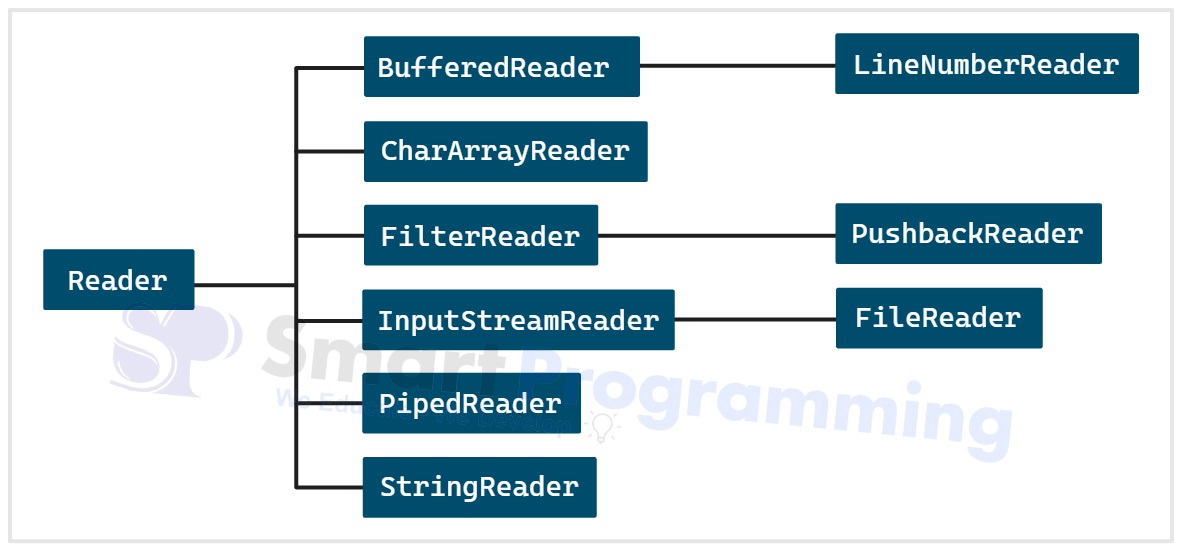Reader Classes
Introduction
-
Readeris an abstract class used to read character-oriented data (16-bit Unicode) from input sources such as files, memory, or network connections. -
It is present in the
java.iopackage. -
It provides basic methods like
read()to read single characters, arrays of characters or lines of text from input sources. -
Unlike
InputStreamwhich deals with bytes,Readeris specifically designed to handle characters, making it suitable for text data.
-
Below is the diagram for Reader class hierarchy:

- Each of these subclasses are designed for specific purposes, which are explained below one by one.
1. BufferedReader
- Description: Reads text from a character input stream efficiently by buffering characters, thus reducing the number of I/O operations.
- Use in Projects: Commonly used to read text files line by line.
-
Example Syntax:
BufferedReader br = new BufferedReader(new FileReader("file.txt")); String line = br.readLine(); br.close();
2. LineNumberReader
-
Description: A subclass of
BufferedReaderthat keeps track of line numbers while reading characters. - Use in Projects: Useful when you need to know the line number while reading files (like compilers or log readers).
-
Example Syntax:
LineNumberReader lnr = new LineNumberReader(new FileReader("file.txt")); String line = lnr.readLine(); int lineNumber = lnr.getLineNumber(); lnr.close();
3. CharArrayReader
- Description: Allows reading characters from a character array as a stream.
- Use in Projects: Useful for testing or when data is already available in a character array.
-
Example Syntax:
char[] data = {'J','a','v','a'}; CharArrayReader car = new CharArrayReader(data); int ch = car.read(); car.close();
4. FilterReader
- Description: An abstract class for filtering character streams, usually extended to add custom functionalities.
- Use in Projects: Rarely used directly; helpful when you need to create a custom filter (e.g., to modify characters while reading).
-
Example Syntax:
// FilterReader is abstract, must be extended // Example: PushbackReader is one implementation
5. PushbackReader
-
Description: A subclass of
FilterReaderthat allows characters to be pushed back into the stream. - Use in Projects: Useful in parsers when you need to “unread” characters for reprocessing.
-
Example Syntax:
PushbackReader pr = new PushbackReader(new FileReader("file.txt")); int ch = pr.read(); pr.unread(ch); // pushes back the character pr.close();
6. InputStreamReader
- Description: A bridge between byte streams and character streams. Reads bytes and decodes them into characters using a specified charset.
-
Use in Projects: Commonly used with
System.infor reading user input as characters. -
Example Syntax:
InputStreamReader isr = new InputStreamReader(System.in); int ch = isr.read(); isr.close();
7. FileReader
-
Description: A convenient subclass of
InputStreamReaderfor reading character files. - Use in Projects: Simplifies reading character files without manually specifying encoding (uses platform default).
-
Example Syntax:
FileReader fr = new FileReader("file.txt"); int ch = fr.read(); fr.close();
8. PipedReader
-
Description: Reads characters from a connected
PipedWriter, used for communication between threads. - Use in Projects: Useful in multithreaded applications for inter-thread communication.
-
Example Syntax:
PipedWriter pw = new PipedWriter(); PipedReader pr = new PipedReader(pw); // one thread writes to pw, another reads from pr
9. StringReader
- Description: Reads characters from a string as a stream.
- Use in Projects: Useful when working with text data already available as a string.
-
Example Syntax:
StringReader sr = new StringReader("Hello Java"); int ch = sr.read(); sr.close();
Help Us Get Better Every Day
Your feedback helps us grow! If there's anything we can fix or improve, please let us know.
We’re here to make our tutorials better based on your thoughts and suggestions.



